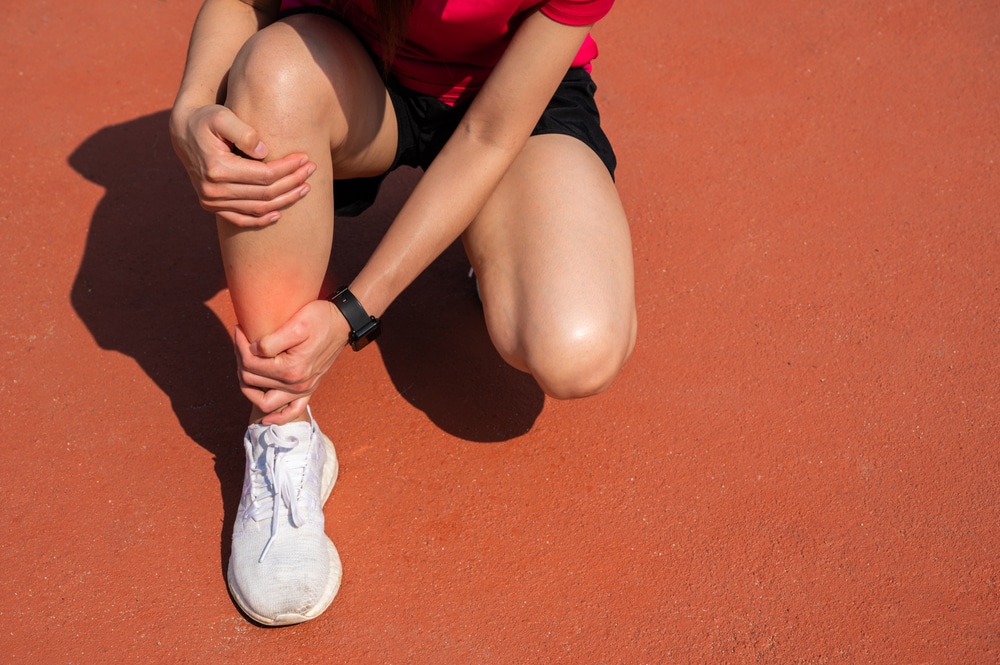Shin splints can put a damper on your fitness routine and daily activities, causing persistent pain and discomfort. But there’s no need to let this common condition hold you back.
At Orthopedic Associates of Long Island, we’re dedicated to helping people recover from various ailments, including shin splints. Our expert physicians are here to guide you through every step of your recovery so you can get back to your active lifestyle – pain-free and stronger than ever.
What Are Shin Splints?
Shin splints, also known as medial tibial stress syndrome, are a common condition associated with exercise. They’re characterized by pain along the inner edge of the shinbone (tibia). This pain is often accompanied by mild swelling and discomfort in the lower leg, just below the knee.
These symptoms usually intensify with physical activity and can result from inflammation of the muscles, tendons, and bone tissue around the shinbone.

What Causes Shin Splints?
Shin splints are caused by repetitive stress and overuse of the muscles, tendons, and bone tissue around your shinbone (tibia). Here are some common factors that contribute to the development of shin splints:
- Sudden Increase in Activity: Starting a new workout routine or increasing the intensity or duration of your exercise too quickly can put extra stress on your shins.
- Improper Footwear: Wearing shoes that lack proper support or cushioning can lead to increased strain on your legs.
- Flat Feet or High Arches: Individuals with flat feet or rigid arches are more likely to develop shin splints due to the uneven distribution of impact forces.
- Running on Hard Surfaces: Exercising on hard or uneven surfaces, like concrete or asphalt, can amplify the impact on your legs.
- Weak or Tight Muscles: Weak or tight calf muscles and Achilles tendons can increase the likelihood of shin splints.
- Poor Running Technique: Incorrect running form or technique can lead to uneven stress on the lower legs, contributing to shin splints.
Treatment for Shin Splints
Effective treatment for shin splints includes a combination of rest, therapeutic interventions, and preventive measures. Here are some treatment options we commonly recommend:
- Rest: Avoid activities that cause pain or discomfort to allow the affected area to heal.
- Ice Therapy: Apply ice packs for 15-20 minutes several times a day to reduce inflammation and pain.
- Anti-inflammatory Medication: Over-the-counter medication like ibuprofen can help manage pain and reduce swelling.
- Physical Therapy: Working with a physical therapist can be highly beneficial. Initial treatments may include moist heat application and massage to control pain and swelling. A physical therapist will also evaluate your walking or running style to suggest modifications to prevent overuse or excessive stress.
- Taping and Orthotics: Taping the arch of the foot can support the tissue and ease pain. Shock-absorbing shoe insoles and orthotics for flat arches can provide additional support and alleviate symptoms.
- Gradual Return to Activity: Once the discomfort subsides, return to physical activity very gradually. Increasing activity levels slowly and incorporating low-impact exercises can help prevent recurrence.
Surgery to repair shin splints is very rare and not always effective. Most patients find relief with non-surgical treatments and preventive measures.
How Are Shin Splints Diagnosed?
Diagnosing shin splints involves a combination of a physical examination, a medical history review, and sometimes imaging tests. Here’s what you can expect during the diagnosis process:
- Medical History: Your doctor will ask about your symptoms, activity level, and any recent changes in your exercise routine. They’ll also inquire about your footwear and any previous injuries or conditions.
- Physical Examination: The doctor will examine your lower legs, looking for signs of tenderness, swelling, and pain along the shin bone. They may ask you to perform certain movements to assess the pain and its location.
- Activity and Biomechanics Assessment: Your doctor might observe your walking or running gait to identify any biomechanical issues that could be contributing to your shin splints.
- Imaging Tests: In some cases, we may order imaging tests like X-rays, bone scans, or MRIs to rule out other conditions, such as stress fractures, compartment syndrome, or tendonitis. These tests can help ensure an accurate diagnosis and appropriate treatment plan.
Shin Splint Prevention Tips
Preventing shin splints is all about taking proactive steps to reduce stress on your legs and improve your overall fitness routine. Here are some effective tips to help you avoid shin splints:
- Gradually Increase Activity Levels: Avoid sudden increases in the intensity or duration of your workouts. Slowly build up your activity levels to give your muscles and bones time to adapt.
- Wear Proper Footwear: Choose shoes that provide good support and cushioning. Replace your shoes regularly, especially if you run frequently, to ensure they maintain their protective features.
- Incorporate Strength Training: Strengthening your leg muscles, especially the calves and shins, can help absorb shock better and reduce the risk of shin splints.
- Stretch Regularly: Regular stretching, particularly of the calf muscles and Achilles tendons, can improve flexibility and reduce strain on your shins.
- Use Shock-Absorbing Insoles: Consider using insoles or orthotics to provide extra cushioning and support, especially if you have flat feet or high arches.
- Run on Softer Surfaces: Whenever possible, choose softer running surfaces like grass or tracks instead of hard surfaces like concrete or asphalt.
- Listen to Your Body: Pay attention to any signs of pain or discomfort in your shins and take them seriously. Rest and seek treatment if necessary to prevent further injury.
Why Choose Orthopedic Associates of Long Island?
Orthopedic Associates of Long Island (OALI) is a top choice for orthopedic care in the greater Long Island and Queens area. We offer a full range of services like sports medicine, joint replacement, spine care, and pediatric orthopedics.
Our team consists of highly qualified, board-certified orthopedic surgeons and specialists known for their expertise in areas such as foot and ankle surgery, hand surgery, and sports medicine. We use the latest medical technology to ensure the best diagnostic and treatment outcomes.
What truly sets OALI apart is our patient-centered approach. We listen to your concerns, create personalized treatment plans, and focus on compassionate care. With multiple convenient locations across Long Island, including East Setauket, Centereach, Commack, Patchogue, Riverhead, Southampton, Wading River, and West Babylon, you can easily access top-quality orthopedic care close to home. Choose OALI for a combination of expertise, advanced technology, and personalized care.
Frequently Asked Questions
Can Shin Splints Go Away on Their Own?
Mild cases of shin splints can improve with rest and self-care. However, it's important to follow proper treatment guidelines for complete recovery and to prevent recurrence. While taking a break from high-impact activities and applying ice can help alleviate symptoms, addressing the underlying causes—such as improper footwear or biomechanical issues—is crucial for long-term relief.
How Can I Tell If I Have Shin Splints or Another Condition?
Shin splints cause pain along the front or inner side of the shin. This discomfort typically worsens with physical activity and can be accompanied by mild swelling or tenderness. Other conditions, such as stress fractures or compartment syndrome, may cause more localized or different types of pain. Stress fractures often result in sharp, pinpoint pain that is tender to the touch, while compartment syndrome may cause a feeling of tightness or pressure in the lower leg.
See one of our providers for a proper diagnosis, as they can conduct a thorough examination and order imaging tests to determine the exact cause of your symptoms.
What Will Happen if I Don’t Address My Shin Splints?
If you ignore your symptoms, they may get worse. The discomfort in your shins may become more intense and constant, making everyday activities and exercise uncomfortable.
Shin splints can even turn into a chronic issue if left untreated. That means you’ll be dealing with a longer recovery time and need more intensive treatment. The continuous stress on your tibia can even lead to stress fractures—tiny cracks in the bone that require lots of rest and can keep you off your feet for weeks or even months. To avoid the pain, you might change the way you walk or run, which can cause additional problems with your knees, hips, or lower back.
How Long Does It Take to Recover From Shin Splints?
Recovery time from shin splints can vary depending on the severity of the condition and how well you adhere to the treatment plan. Generally, with proper care, you can expect to recover within a few weeks. Here’s an estimated timeline:
- Mild Cases: If you catch shin splints early and start treatment right away, you might see improvement in as little as one to two weeks.
- Moderate Cases: For more pronounced pain and swelling, recovery might take three to six weeks. This period includes rest, ice therapy, and gradual reintroduction to activity.
- Severe Cases: In severe cases or if shin splints have developed into stress fractures, recovery can take several months. This extended period allows for adequate rest and possibly physical therapy to rebuild strength and flexibility.
Reclaim Your Stride with Orthopedic Associates of Long Island
Don’t let shin splints hold you back from living an active life. Our team at Orthopedic Associates of Long Island is here to help you recover and get back to doing what you love.
Take the first step towards relief today. Call us at 631-689-6698 to schedule your appointment.
With personalized treatment plans and expert care, we’ll guide you through your recovery.


